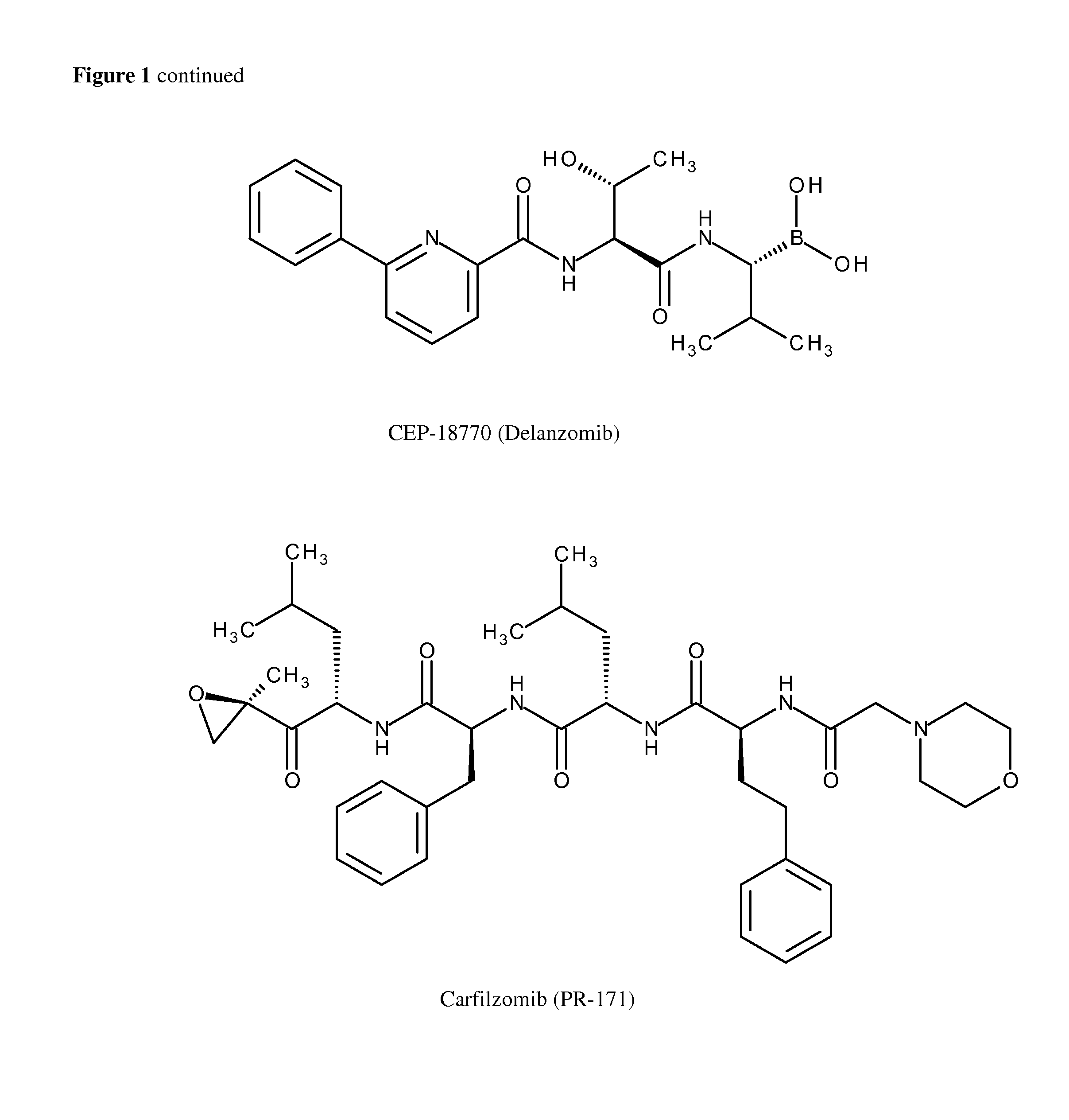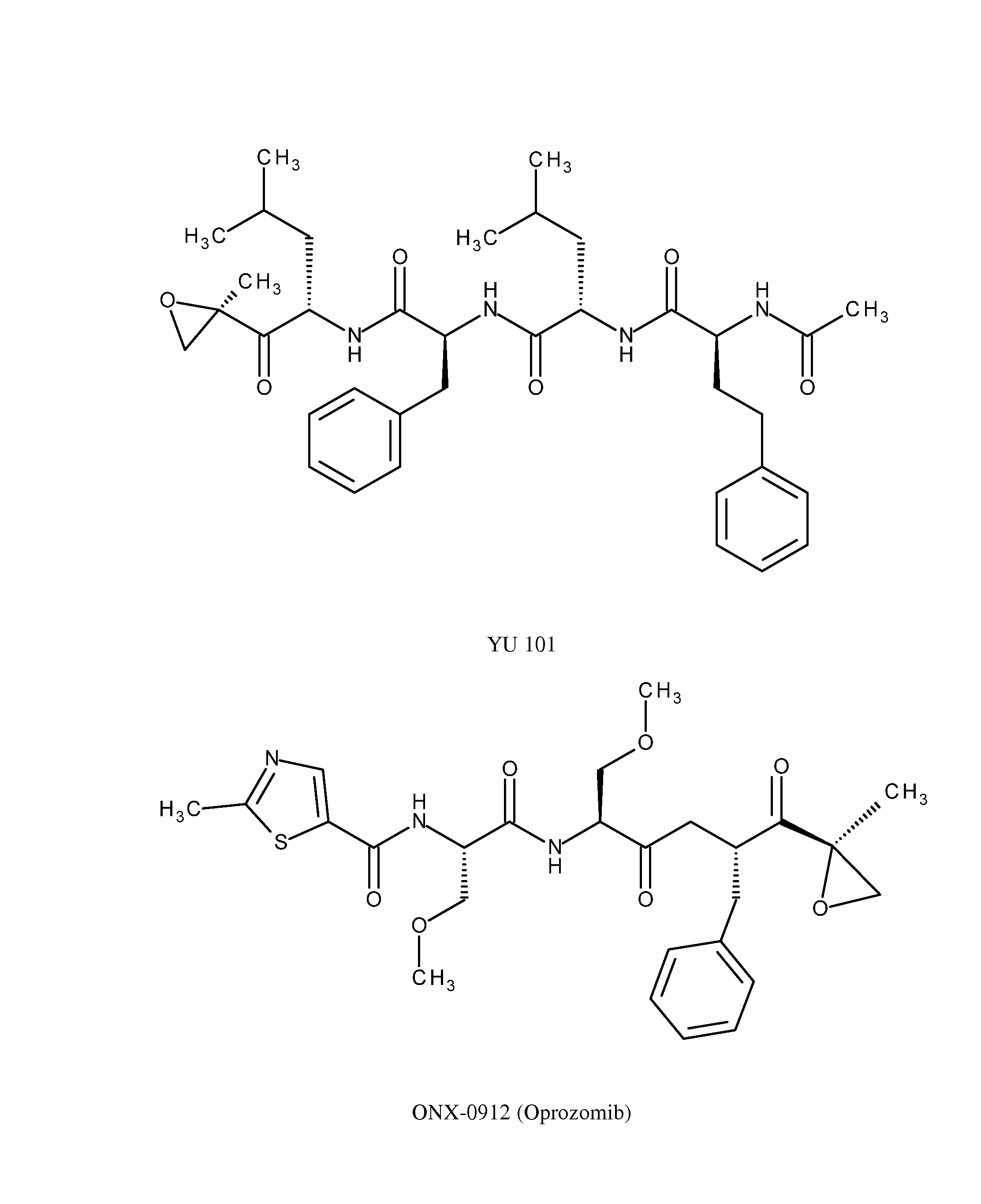Method for the Treatment of Neuropathies Associated with Charcot-Marie-Tooth 1A (CMT1A) Disease
a neuropathology and charcotmarietooth technology, applied in the field of proteasome inhibitors, can solve the problems of nerve degeneration and muscle weakening, varying degrees of hand weakness, and patients slowly losing normal use of their extremities
- Summary
- Abstract
- Description
- Claims
- Application Information
AI Technical Summary
Benefits of technology
Problems solved by technology
Method used
Image
Examples
example 1
PMP22 Expression in S16 Schwann Cells.
[0045]To determine if proteasome inhibitors affect endogenous PMP22 expression, quantitative rtPCR was utilized to measure the abundance of PMP22 mRNA transcript in the S16 Schwann cells, which were plated in 6 well plates and treated with each compound at the indicated concentrations. After 24 h., the cells were harvested to purify RNA, 1 μg of which was converted into cDNA. Quantitative rtPCR was performed in either SYBR green-based reactions or Taqman-based customized 384-well micro fluidic arrays using a ViiA7 system or StepOne Plus (Applied Biosystems). Abundance of gene expression was first normalized to beta-actin (ActB, NM—031144.2) or 18 S rRNA, which served as an endogenous loading control across samples, and then determined relative to the untreated sample for each gene using the comparative Ct method described by K. J. Livak and T. D. Schmittgen (Analysis of relative gene expression data using real-time quantitative PCR and the 2ΔΔCT...
example 2
Effect of MLN9708 on PMP22 Expression in Mice.
[0046]Results show relative levels of PMP22 after a single subcutaneous (s.c.) injection of MLN9708 at a dose equivalent to 10 mg substance / kg of body weight. MLN9708. Anatomical areas of subcutaneous administration could include the right or left thigh, or abdomen. The same anatomical area can be used for repeated administration. However, injections are typically to be rotated between sites (see; Fledrich, R. M. et al., Murine therapeutic models for Charcot-Marie-Tooth (CMT) disease. British Medical Bulletin, 2012, 102, 89-113).
CompoundConcentrationTotal PMP22MLN9708, n = 410 mg / kg 1.00 ± 0.09Vehicle, n = 50.739 ± 0.07
example 3
[0047]Effect of Bortezomib on PMP22 expression in CMT1A rats.
[0048]Bortezomib was administered subcutaneously (s.c.) at a dose equivalent to 0.1 mg substance / kg of body weight, using an injection concentration of 2.5 mg of substance / ml. RNA was purified from sciatic nerve at 7 d post-injection. Results show relative levels of PMP22 and the 2 isoforms as determined by quantitative rtPCR. Errors indicate the standard error of the mean (SEM).
DrugGeneVehicle n = 8Treated n = 9Bortezomib 0.1 mg / kgTotal PMP221.00 ± 0.03 0.3 ± 0.057 d post-injectionPMP22 P11.00 ± 0.100.675 ± 0.17PMP22 P21.00 ± 0.09 0.4 ± 0.07
PUM
| Property | Measurement | Unit |
|---|---|---|
| body weight | aaaaa | aaaaa |
| body weight | aaaaa | aaaaa |
| body weight | aaaaa | aaaaa |
Abstract
Description
Claims
Application Information
 Login to View More
Login to View More - R&D
- Intellectual Property
- Life Sciences
- Materials
- Tech Scout
- Unparalleled Data Quality
- Higher Quality Content
- 60% Fewer Hallucinations
Browse by: Latest US Patents, China's latest patents, Technical Efficacy Thesaurus, Application Domain, Technology Topic, Popular Technical Reports.
© 2025 PatSnap. All rights reserved.Legal|Privacy policy|Modern Slavery Act Transparency Statement|Sitemap|About US| Contact US: help@patsnap.com



